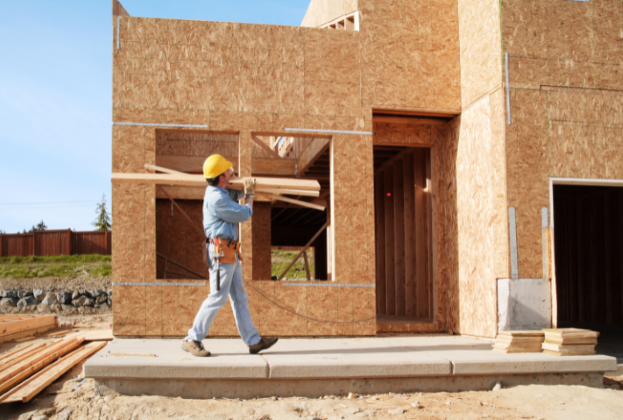
Housing Starts Fall For 4th Straight Month

2022 posts 3% YOY decline, the first overall drop since 2009.
- December housing starts fell 1.4% from November, and were down 21.8% YOY.
- Single-family starts, however, jumped 11.3% in December, but were still down 25% YOY.
- Starts skyrocketed in December in the Northeast, which saw a 135.6% jump.
December wrapped up a terrible year for new home construction, posting the fourth straight monthly drop in housing starts as 2022 ended with a 3% overall decline — the first annual drop since 2009.
At least one economist, however, sees signs that the worst may be over for the homebuilding industry.
According to the report released Thursday by the U.S. Census Bureau and the U.S. Department of Housing and Urban Development, privately owned housing starts in December were at a seasonally adjusted annual rate of 1.38 million, 1.4% below the revised November estimate of 1.4 million and a 21.8% drop from a year earlier. December’s results beat analysts’ expectations.
The December rate for buildings with five or more units was 463,000, down 18.9% from November and down 16.3% from December 2021.
Single‐family housing starts in December, however, were at a rate of 909,000, 11.3% above the revised November figure of 817,000 but still 25% below the rate for December of last year.
Construction began on an estimated 1.55 million housing units in 2022, 3% below the 2021 figure of 1.6 million.
By region, the overall increase in housing starts was led by the Northeast, which reported a rate of an annual rate in December of 212,000, a 135.6% increase from November and a 50.4% increase year over year. The Northeast’s total included a 96.9% increase in single-family housing starts. Housing starts fell overall in the Midwest (-37.4%), South (-4%), and West (-9.5%).
Completions, Permits Fall
Newly constructed homes were completed in December at a seasonally adjusted annual rate of 1.4 million, 8.4% below the revised November estimate of 1.54 million but 6.4% above the December 2021 rate.
Single‐family housing completions in December were at a rate of 1 million, 8% below the revised November rate of 1.09 million but just 0.9% down from a year earlier. The December rate for buildings with five units or more was 385,000, down 12.1% from the revised November rate of 438,000 but up nearly 26& from a year earlier.
An estimated 1.39 million housing units were completed in 2022, 3.8% above the 1.34 million completed a year earlier.
Privately owned housing units authorized by building permits in December were at a seasonally adjusted annual rate of 1.33 million, 1.6% below the revised November rate and 29.9% below the December 2021 rate.
Single‐family permits authorized in December were at a rate of 730,000, 6.5% below the revised November figure of 781,000 and nearly 35% below the rate a year earlier. Authorizations of buildings with five or more units were at a rate of 555,000 in December, up 7.1% from the rate of 518,000 in November but still down nearly 22% from a year earlier.
An estimated 1.65 million housing units were authorized by building permits in 2022, 5% below the 2021 figure of 1.74 million.
'Worst May Be Over'
Odeta Kushi, deputy chief economist for First American Financial Corp., said the report does include some signs that the “worst of the housing downturn may be over.”
She noted that single-family permits — a leading indicator of future starts — fell 6.5% from November and 35% year over year, and that single-family completions have outpaced starts since July 2022, reducing the number of homes under construction.
Construction of multi-family homes, however, tell a different story, she said.
“While the number of single-family homes under construction is stabilizing as builders cut production, multi-family construction continues to hit new records,” Kushi said. “Starts are exceeding completions, and there are a record 926,000 multi-family units under construction. More multi-family supply may ultimately put some downward pressure on rents over the next year or so.”
In addition, she said, “Homebuilder sentiment increased for the first time in a year in January due to lower mortgage rates, though general perceptions among builders remain poor. As mortgage rates moderate and with the spring season around the corner, it’s possible that the worst of the impact to sales is behind us.”
Kushi said builders continue to offer incentives — such as price cuts, paying points, and providing mortgage rate buy-downs — to bolster sales and entice buyers back into the market.
She also said the inventory of new homes on the market continues to increase.
“From 2000 until the pandemic, new homes on average made up approximately 11% of total inventory,” Kushi said. “Today, that share has skyrocketed to 29% as existing homeowners stay put, while new-home inventory rises.”
Builders have a large backlog of single-family homes under construction, she said, and will likely continue to focus on completing those projects rather than starting new ones “until there is a meaningful and sustained increase in demand.”
“The housing market remains fundamentally underbuilt and as demand rises, it will be important to boost supply in order for price growth to continue to adjust to more sustainable levels,” she added. “While builders can’t make existing homeowners move, they can add new homes to the stock.”




